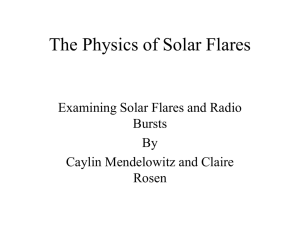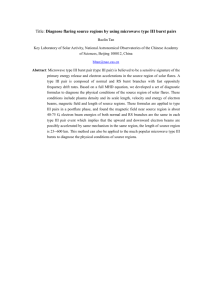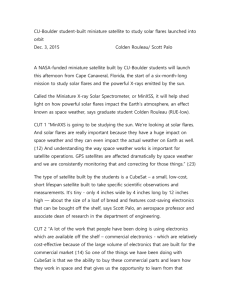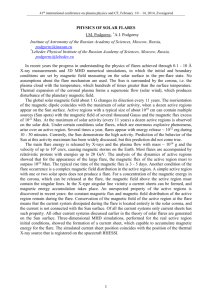TITLE OF THE PAPER
advertisement
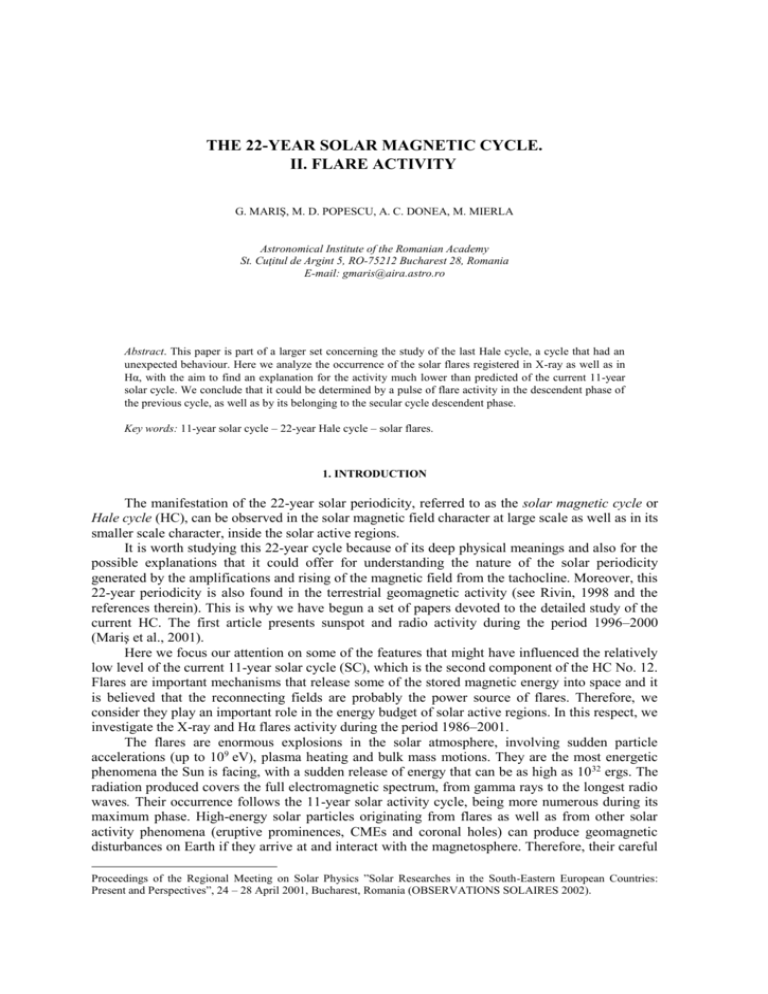
THE 22-YEAR SOLAR MAGNETIC CYCLE. II. FLARE ACTIVITY G. MARIŞ, M. D. POPESCU, A. C. DONEA, M. MIERLA Astronomical Institute of the Romanian Academy St. Cuţitul de Argint 5, RO-75212 Bucharest 28, Romania E-mail: gmaris@aira.astro.ro Abstract. This paper is part of a larger set concerning the study of the last Hale cycle, a cycle that had an unexpected behaviour. Here we analyze the occurrence of the solar flares registered in X-ray as well as in Hα, with the aim to find an explanation for the activity much lower than predicted of the current 11-year solar cycle. We conclude that it could be determined by a pulse of flare activity in the descendent phase of the previous cycle, as well as by its belonging to the secular cycle descendent phase. Key words: 11-year solar cycle – 22-year Hale cycle – solar flares. 1. INTRODUCTION The manifestation of the 22-year solar periodicity, referred to as the solar magnetic cycle or Hale cycle (HC), can be observed in the solar magnetic field character at large scale as well as in its smaller scale character, inside the solar active regions. It is worth studying this 22-year cycle because of its deep physical meanings and also for the possible explanations that it could offer for understanding the nature of the solar periodicity generated by the amplifications and rising of the magnetic field from the tachocline. Moreover, this 22-year periodicity is also found in the terrestrial geomagnetic activity (see Rivin, 1998 and the references therein). This is why we have begun a set of papers devoted to the detailed study of the current HC. The first article presents sunspot and radio activity during the period 1996–2000 (Mariş et al., 2001). Here we focus our attention on some of the features that might have influenced the relatively low level of the current 11-year solar cycle (SC), which is the second component of the HC No. 12. Flares are important mechanisms that release some of the stored magnetic energy into space and it is believed that the reconnecting fields are probably the power source of flares. Therefore, we consider they play an important role in the energy budget of solar active regions. In this respect, we investigate the X-ray and Hα flares activity during the period 1986–2001. The flares are enormous explosions in the solar atmosphere, involving sudden particle accelerations (up to 109 eV), plasma heating and bulk mass motions. They are the most energetic phenomena the Sun is facing, with a sudden release of energy that can be as high as 10 32 ergs. The radiation produced covers the full electromagnetic spectrum, from gamma rays to the longest radio waves. Their occurrence follows the 11-year solar activity cycle, being more numerous during its maximum phase. High-energy solar particles originating from flares as well as from other solar activity phenomena (eruptive prominences, CMEs and coronal holes) can produce geomagnetic disturbances on Earth if they arrive at and interact with the magnetosphere. Therefore, their careful Proceedings of the Regional Meeting on Solar Physics ”Solar Researches in the South-Eastern European Countries: Present and Perspectives”, 24 – 28 April 2001, Bucharest, Romania (OBSERVATIONS SOLAIRES 2002). The 22-Year Solar Magnetic Cycle. II. Flare Activity 49 monitoring is very important not only for solar physics but also for other interdisciplinary studies as space weather and climatology. This paper has the following structure: Section 2 is a short review of the Hale cycle. In Section 3 we present the data analysis of the flare occurrence during the selected period: the time distribution over the current HC (Subsection 3.1), the daily flare indices (Subsection 3.2), together with their butterfly diagram (Subsection 3.3). Section 4 sums up the results and gives our comments and conclusions. 2. THE HALE CYCLE The magnetic polarity of the preceding and the following spots of the bipolar regions reverse from one 11-year cycle to the next in each solar hemisphere. G. E. Hale first noted this feature in 1919 and since then, a new unit of the solar periodicity has been taken into consideration: the 22year magnetic cycle. This cycle is composed of two 11-year cycles and is also referred to as the Hale cycle (HC). The polar field reversal, following the sunspot maximum (first noted by Babcock and Babcock, 1955), has enforced the idea that the 22-year solar cycle has a strong physical meaning, making a connection between the pair of two statistically defined 11-year solar cycles. As we already mentioned in our first paper devoted to the study of the current (No. 12) HC (Mariş et al., 2001), the choice of the cycle pairing is “even-odd”, having the 11-year cycle No. 1 as the second component of the first HC. The majority of the Hale cycles seemed to follow a certain “rule”: the second 11-year cycle of the pair is more powerful. This is known as the Gnevyshev-Ohl rule (G-O rule; Gnevyshev and Ohl, 1948). The fact that odd cycles have larger amplitudes than even ones proved to be true during the last 140 years (e.g. Durney, 2000). This is the principal reason for which it was generally predicted a much higher value of the smoothed sunspot number, as well as of other solar activity indices, for the current 11-year cycle. Moreover, based on the G-O rule predictions, it was expected that the SC 23 would be the highest ever observed. This supposition was based on the fact that the preceding cycle from the current pair had a high maximum (with the maximum smoothed sunspot number Rm22 = 158), higher than for the even pair of the SC 19, which was the largest solar cycle observed. 250 200 HC 3 HC 12 HC 5 150 100 50 1992 1983 1974 1964 1955 1946 1936 1927 1918 1908 1899 1890 1880 1871 1862 1852 1843 1834 1824 1815 1806 1796 1787 1778 1768 1759 1750 0 Fig. 1 – The smoothed sunspot numbers (1750–2001). The Hale cycles that did not obey the G-O rule are marked (on the data provided by WDC-A for Solar–Terrestrial Physics, NOAA E/GC2, Broadway, Boulder Colorado 80303, USA). G. Mariş et al. 50 Since now the maximum already passed, we have the certainty that this empirical method for prediction of the cycle amplitude failed: the 23rd solar cycle has a lower intense activity than the previous one (Rm23 = 120). The only two HCs that had such a behaviour were the cycles Nos. 3 (1784–1809) and 5 (1833–1855) (see Fig. 1). That raises the percentage of the HCs that violate the G-O rule to 25% of the 12 cycles monitored during the last 250 years. From Schove series, the only data set of reconstructed 11-year cycle characteristics (the period 296–1996), 37% of the 76 examined pairs of even-odd 11-year cycles violate the rule (Komitov and Bonev, 2001). These authors conclude that the strength of the even SC is the main factor of the G-O violations. 3. DATA We investigate the flare occurrence during the present Hale cycle (1986–2001). Both X-ray and Hα class of flares were considered. The time distribution of these flares over the current HC, the daily flare indices, as well as an analysis of their spatial distribution were considered. Data used in this study were provided by WDC-A for Solar–Terrestrial Physics, NOAA E/GC2, Broadway, Boulder Colorado 80303, USA. 3.1. TIME DISTRIBUTION Jan-02 Jan-01 Jan-00 Jan-99 Jan-98 Jan-97 Jan-96 Jan-95 Jan-94 Jan-93 Jan-92 Jan-91 Jan-90 Jan-89 Jan-88 100 80 60 40 20 Jan-8 6 Jan-8 7 Jan-8 8 Jan-8 9 Jan-9 0 Jan-9 1 Jan-9 2 Jan-9 3 Jan-9 4 Jan-9 5 Jan-9 6 Jan-9 7 Jan-9 8 Jan-9 9 Jan-0 0 Jan-0 1 Jan-0 2 Jan-87 Jan-88 Jan-89 Jan-90 Jan-91 Jan-92 Jan-93 Jan-94 Jan-95 Jan-96 Jan-97 Jan-98 Jan-99 Jan-00 Jan-01 Jan-02 0 Jan-86 M and X-type flares Jan-87 350 300 250 200 150 100 50 0 Jan-86 C-type flares We analyse the time distribution for X-ray and Hα flares as listed in the SGD, by the monthly number of the events. For the period January 1986 – March 2001 there was a number of 14,955 Xray flares. We overviewed their monthly distribution by splitting them into two categories (Fig. 2): C, M and X type flares 400 350 300 250 200 150 100 50 0 Fig. 2 – The monthly distributions of the X-ray flares during January 1986 – March 2001 (C-type flares, upper panel; M & X-type, middle panel; C, M & X type, bottom panel). The 22-Year Solar Magnetic Cycle. II. Flare Activity 51 - medium energetic – C-type (12,146 events) and, - high energetic – M and X type (2,809 events). The histograms representing the number of the C, M and X-type solar flares (no./month) during the period January 1986 – March 2001 show some differences between the pair of the two 11-year cycles considered: - - For SC 22, X-ray flares showed a remarkable increase during 1988, a high activity during the following two years (1988–1989) and a second maximum during 1991. After 1991, the activity began the descendent phase but had a sudden growth for the period June 1994 – May 1995. The whole cycle is characterized by an alternation of the activity between C-type and M & X-type solar flares. For the 23rd SC, X-ray flare activity increased after the end of 1997 for both classes of X-ray flares, until the year of maximum solar activity (2000). The high flare activity after November 1999 could be remarked. The highest C-type X-ray flare activity took place in March 2000 (with a number of 303 flares of this type). Four maxima are revealed for the M & X-class of X-ray flares in November 1999 (41 M & X-class flares), March 2000 (40 flares), July 2000 (54 flares) and March 2001 (38 flares), the third being the highest. We have found a very similar behaviour H flares, too. A very detailed statistical analysis for this type of flares is given by Temmer et al. (2001). 3.2. FLARE INDICES For evaluating the X-ray flares, we quantified them through the total energy emitted in X-ray wavelengths over a period of 24 hours. Thus, we defined an index Qx through the formula (1) and we calculated its values over the period January 1986 – March 2001. Qx i x t (1) where ix is the intensity scale of importance of the X-ray flare spectral class and t is the duration of the flare in minutes. Based on the classification of solar flares in X-ray according to the magnitude order of the peak burst intensity measured at the Earth by satellites within 1–8 Å, we defined ix as in Table 1. Table 1 The ix coefficient values for the different spectral classes of X-ray flares. X-ray class 1.1-5.0 C 5.1-9.9 C 1.1-5.0 M 5.1-9.9 M 1.1-5.0 X 5.1-9.9 X ix 1.0 1.5 2.0 2.5 3.0 3.5 In Fig. 3 (upper panel) one can see the temporal variation of this index during the chosen period. A curiously intense activity at the onset of the 22nd 11 year cycle (QX > 0.2) in the periods: June - October 1994; December 1994 – May 1995; October 1995, is the most interesting feature of this plot. Fig. 4 (upper panel) presents the annual values of the QX index. For a similar evaluation of the H flares energy release, we used the index Q computed by Ataç and Özgüç (2001) from January 1986 to March 2001. This is an index introduced by Kleczek, (1952) for describing the H flare activity over a 24 hours period: G. Mariş et al. 52 Q it , (2) 2 20 1.6 16 Qx (annual values) 1.2 0.8 0.4 4 Fig. 3 The monthly variations of the Qx index for the X-ray flares (upper panel) and of the Q index for Hα flares (bottom panel) during the period January 1986 – March 2001. 1996 1997 1998 1999 2000 1998 1999 2000 1994 1993 1992 1991 1990 1989 1988 1994 1993 1992 1991 1990 0 1989 Jan-01 Jan-00 Jan-99 Jan-98 Jan-97 Jan-96 Jan-95 Jan-94 Jan-93 Jan-92 Jan-91 Jan-90 Jan-89 Jan-88 Jan-87 Jan-86 0 40000 1988 5000 80000 1987 10000 1997 120000 1995 15000 1996 160000 1995 20000 1987 1986 Jan-01 Jan-00 Jan-99 Jan-98 Jan-97 Jan-96 Jan-95 Jan-94 Jan-93 Jan-92 Jan-91 Jan-90 Jan-89 Jan-88 Jan-87 8 0 Q (annual values) Q (monthly values) Jan-86 0 12 1986 Qx ( monthly values) where i represents the intensity scale of importance of a flare in Hand t the duration of the flare in minutes. It is assumed that this relationship gives roughly the total energy emitted by flares in the Hline. The histograms of the Q index are given in the bottom panels of Fig. 3 (monthly values, January 1986 – March 2001) and Fig. 4 (annual values, 1986–2000). Fig. 4 The annual variations of the QX index (upper panel) and of the Q index (bottom panel) for the solar flares during the interval 19862000. The annual values of the QX index (Fig. 4, upper panel) show a very sharp growth during the ascending phase of the SC 22 and two maxima, in 1989 and 1991, the first one being the highest. SC 23 presents a lower flare energy release on the ascending phase in comparison with SC 22 and also a steeper slope. The values of the Q index reveal practically the same variations as the ones of the QX index. One can observe that the values of the two maxima are very close. These epochs are coincident with the maximum ones for the sub-flares (in 1989) and the flares of importance 2 (in 1991), respectively. This means that the Q index appreciates the annual values of energy released by the flares of the two importance classes as being about the same. The cycles 22 and 23 are different in the level of flare activity and in the slope and the duration of their ascending branch. SC 23 is very similar with SC 20, but they have a different position into a 22-year cycle unit (Fig.4). 3.3. BUTTERFLY DIAGRAMS The butterfly diagram, first plotted by Maunder in 1922, is a graphical representation of the sunspot occurrence in respect to the solar latitude. The same representation can be made also for The 22-Year Solar Magnetic Cycle. II. Flare Activity 53 flares. It gives a very good view on the latitude dependence of the flare appearance during the activity cycle. 3.3.1. X-ray flares The first X-ray flares of the solar cycle No. 22 appeared sporadically at the end of 1986 in North at about 20o–30o latitude, most of them being of class C. Their latitude increased over 30o in 1987, both in North and in South, and there are just a few events at latitudes higher than 40 o in the period 1987–1990, only two of them being of class M & X, in the northern hemisphere. The flare occurrence at latitudes higher than 30o lasted until the second half of 1991 in North and the end of 1992 in South. The shift of flare zones towards the equator took place until 1991, and then they followed a path parallel to it, centered on a medium latitude of about 10o until the end of the cycle. The same behaviour is observed also for the flare diagram of C and M & X types, drawn separately. There is an interesting temporal connection observed in both hemispheres when the cycle 22 finishes. The last southern flares belonging to this cycle occur at the very end of 1996 (around 5 o– 0o) and they are immediately followed by the first flares of the 23 rd cycle in the same hemisphere (at 20o–30o). The last northern flares of the 22nd cycle occur about half a year later (at 5o-0o), followed by the first northern flares of the next cycle (at 17o–32o). During the cycle 23 there are fewer flares at latitudes higher than 30o in comparison to the ascending and maximum phases of the previous cycle; they appear at the half of 1998 in North and at the end of the same year in South. It is also obvious that the flares are very rare in the southern hemisphere during the ascending phase of the current 11-year cycle, contrary to the southern dominance observed all along the previous cycle. The shift of flare occurrence areas towards the equator ends during the year 2000 in both hemispheres; we can observe that, practically, in the year of maximum, there are flares already appearing at the latitudes smaller than 10o. We did not meet this characteristic at the previous cycle, when in the year of maximum the flare area was higher than 10 o. We assume that this is related to the reversal of the magnetic polarity, which, for SC 22, took place in 1991–1992, and for SC 23, in 2000–2001. 3.3.2. Hα flares The butterfly diagram of Hα flares is very similar to the one for X-ray flares, only that it contains a bigger number of events. The solar cycle 22 ends at the beginning of 1997 in the southern hemisphere and at the half of the same year in the Northern one. The same temporal connection between the flares belonging to the old and to the new cycle, in both hemispheres, observed for the X-ray butterfly diagram is also remarked here. The only difference is that the first flares of the 23rd cycle are preceding by 2–3 months the ending of the 22nd cycle flares, in both hemispheres. Obviously, the first flares of the cycle are of a small importance (subflares). 3.3.3. Common features For both X-ray and Hα classes of flares, the general trend of their butterfly diagram is given by the less energetic flares, which are, of course, most numerous. A remarkable feature is a very small number of energetic flares (M & X class X-ray flares and importance ≥ 1 Hα flares) during the period 1995–1997. For the SC 23 the shift of flare areas towards the equator takes place in the year of maximum, unlike the previous cycle, when this trend is observed two years after 1989. This could indicate a possible shorter duration for the current cycle. 54 G. Mariş et al. The flare diagrams present as a basic feature a “nervure” structure from the highest latitudes to the lowest ones, in both hemispheres, for the entire interval studied. The structure is less evident for the current cycle than for the previous one, but it can still be defined as a “fingerprint” for both types of flares considered in the present study. A representation of the butterfly diagrams for a shorter interval (a few solar rotations) confirms the temporal dimension of this “nervure”: approximately 13–14 days. The agglomeration of flares for a half rotation period could be obviously due to the presence on the visible solar disc of some very prolific active zones. The existence of the so-called “superactive regions” on the Sun, which are large, magnetically complex and thus very productive in flares, was speculated in the literature by other authors, too (e.g. Verma, 1987; Bai, 1987; 1988). Fig. 5 Butterfly diagram for X-ray flares (1986 – 2001) (on the data provided by WDC-A for Solar –Terrestrial Physics, NOAA E/GC2, Broadway, Boulder Colorado 80303, USA). 4. COMMENTS AND CONCLUSIONS The histograms, as plotted in Fig. 2, reveal the rate of flare occurrence during the solar activity cycle. During the periods with a high rate of energetic flares (as December 1990 – February 1992) there is a very small number of less intense flares and vice-versa (see also the periods with a low level of energetic flares as December 1989 – November 1990 and March 1992 – August 1992). Moreover, one can clearly observe that while the number of M & X type flares for SC 23 is smaller than for SC 22, the total number of C-type flares during SC 23 is bigger than during SC 22. This is a confirmation of the fact that a cycle with a high rate of small-energy flares produces a lower number of high-energy flares than a cycle with less small-energy releases. It means that if there are many small releases of magnetic energy there is little chance that big amounts of energy can be stored before the destabilization. Therefore, a C-type flare dominance for a certain period leads to the nearly complete absence of high-energy flares, characteristic that can The 22-Year Solar Magnetic Cycle. II. Flare Activity 55 be extended to the whole length of a cycle. A similar result was also confirmed by other authors: Dinulescu et al. (1994) in a study of some δ sunspot groups from the cycles 21 and 22, and Temmer et al. (2001) in their statistical analysis of Hα flares during the last three cycles. Actually, it has been found that the frequency of events is related to their energy by an inverse power law (Longcope, 2001). Nevertheless, from Figs. 3 and 4, which represent the histograms of the two indices that evaluates the total energy released by all Hα and respectively X-ray flares, it is obvious that the maximum value reached during the current cycle is lower than for the previous one. This trend confirms the lower level of solar activity during the SC 23 seen for the relative sunspot number, too (see Fig. 1). The flare activity showed a sudden growth in the period June 1994 – May 1995, a year before the minimum of SC 22. This is best seen in Fig. 3 (upper panel), which presents the monthly values of the X-ray flare index. Such anomaly was also noticed for the previous cycles Nos. 19, 20 and 21 (Dinulescu and Dinulescu, 1991). The strength of the following cycle could be related to the relative intensity of this ”pulse”, because it implies a certain release of magnetic energy that could cause a serious deficit for its estimated energy discharge. We consider that this could be a cause of the level lower than estimated for the current 11-year cycle. Another possible cause for the low intensity of the 23rd SC could be its position in the secular solar cycles. The HC No. 12 presently analyzed is situated on the descending phase of both 200 and 100 year solar cycles, as well as in the quiet phase of the 2400 year cycle (Komitov and Bonev, 2001). The other two HCs that violated the G-O rule had a similar position in this long-term cycle. The second component of HC 3 was situated on a descendent phase of the secular cycle and the second 11-year cycle of HC 5 was in the gap between the two maxima of the following secular cycle (see Fig. 1). Because the nature of the magnetic 22-year cycle is determined by the reversal of the polar magnetic field, the relative strength of the two components depends on intrinsic factors ruled by the generation of the magnetic field in the tachocline and on the way in which the energy budget is shared between the two 11-year cycles. Thus, the G-O rule could not have any physical significance, even if it proved to be statistically true for most of the HCs. Acknowledgements. Data used in this study were provided by WDC-A for Solar–Terrestrial Physics, NOAA E/GC2, Broadway, Boulder Colorado 80303, USA. This paper was partially supported by the priority program no.3/2001 of the Romanian Academy. REFERENCES Ataç, T., Özgüç, A.: 2001, Solar Phys., 198, 399. Babcock, H. W., Babcock, H. D.: 1955, Astrophys. J., 121, 349. Bai, T.: 1987, Astrophys. J., 314, 795. Bai, T.: 1988, Astrophys. J., 328, 860. Dinulescu, S., Dinulescu, V.: 1991, Rom. Astron. J., 1, 63. Dinulescu, S., Dimitriu, A., Mariş, G.: 1994, Rom. Astron. J., 4, 161. Durney, B. R.: 2000, Solar Phys., 196, 421. Gnevyshev, M. N., Ohl, A. I.: 1948, Astron. Zh., 25, 18. Kleczek, J.: 1952, Publ. Inst. Centr. Astron., No. 22, Prague. Komitov, B., Bonev, B.: 2001, Astrophys. J., 554, L119. Longcope, D. W: 2001, AGU Meeting, abstract SP51C-02. Mariş, G., Oncica, A., Popescu, M. D.: 2001, Rom. Astron. J., 11, 13. Rivin, Y.R.: 1998, Int. J. of Geomagn. and Aeronomy, 1, No. 2 (http://ijga.agu.org). Verma, V. K., Pande, M. C., Udin, W.: 1987, Solar Phys., 112, 341. Temmer, M., Veronig, A., Hanslmeier, A., Otruba, W., Messerotti, M.: 2001, Astron. Astrophys., 375, 1049.
